java多线程详细讲解 线程的创建、线程的状态、synchronized锁、Volatile关键字、和cas锁(自旋锁 乐观锁 无锁)

java多线程详细讲解 线程的创建、线程的状态、synchronized锁、Volatile关键字、和cas锁(自旋锁 乐观锁 无锁)
-
- 一、线程的概念
- 二、创建线程的三种方式
- 三、线程方法Sleep、Yield、Join
- 四、线程的执行状态
- 五、synchronized关键字
-
- 1.为什么要上锁?
- 2.锁定的内容是什么?
- 3.synchronized加锁的方式
- 4.同步方法和非同步方法是否可以同时调用?
- 5.面试题:模拟银行账户,对业务写方法加锁,对业务读方法不加锁,这样行不行?
- 6.synchronized是否是可重入锁?
- 7.程序中出现异常,锁是否会被释放?
- 8.synchronized的底层实现
- 六、Volatile关键字
-
- 1.保证线程可见性
- 2.禁止指令重排序(CPU)
- 七、CAS(Compare And Swap /Set / Exchange)(自旋锁 乐观锁) (无锁)
-
- 1.AtomicInteger类
- 2.Unsafe类
-
- 1)Unsafe类的C++源码追踪
- 2) C++中cmpxchg方法解释
一、线程的概念
每个线程可以理解为单独的任务线,可以同时执行。如烧开水和扫地两件事可以同时进行。
二、创建线程的三种方式
继承Thread类、实现Runnable接口、或者使用lambda表达式
static class MyThread extends Thread {@Overridepublic void run() {System.out.println("Thread");}}static class MyRunnable implements Runnable {@Overridepublic void run() {System.out.println("Runnable");}}public static void main(String[] args) {new MyThread().start();new Thread(new MyRunnable()).start();new Thread(() -> System.out.println("lambda")).start();}三、线程方法Sleep、Yield、Join
- Sleep是线程睡眠,cpu可以执行其他线程。睡眠时间结束继续执行。
- Yield 暂时让出执行权,当前线程和其他线程一起抢夺cpu执行权。
- Join 线程1中执行线程2.join的含义是,执行完线程2证继续执行线程1剩余代码。
public static void main(String[] args) {
// testSleep();
// testYield();testJoin();}static void testSleep() {new Thread(() -> {for (int i = 0; i < 100; i++) {System.out.println("A" + i);try {Thread.sleep(500);} catch (InterruptedException e) {e.printStackTrace();}}}).start();}static void testYield() {new Thread(() -> {for (int i = 0; i < 100; i++) {System.out.println("A" + i);if (i % 10 == 0) {Thread.yield();}}}).start();new Thread(() -> {for (int i = 0; i < 100; i++) {System.out.println(" B " + i);if (i % 10 == 0) {Thread.yield();}}}).start();}static void testJoin() {Thread t1 = new Thread(() -> {for (int i = 0; i < 100; i++) {System.out.println("A" + i);try {Thread.sleep(50);} catch (InterruptedException e) {e.printStackTrace();}}});Thread t2 = new Thread(() -> {System.out.println(" b start ");try {t1.join();} catch (InterruptedException e) {e.printStackTrace();}for (int i = 0; i < 100; i++) {System.out.println("b" + i);try {Thread.sleep(50);} catch (InterruptedException e) {e.printStackTrace();}}System.out.println(" b end ");});t1.start();t2.start();}
四、线程的执行状态
1.线程在被创建(new)还没有调用start方式时,状态为NEW。
2.线程被调用start方法后被线程调度器执行(Runnbale)。其中有分为两种状态:就绪状态(Ready)、运行状态(Running)(就绪状态中的县城被调度器选中执行后进入运行状态)。
3.线程执行结束进入线程结束状态(Teminated)[注意线程结束后不可以再次调用start方法]
4.除正常执行结束线程外,还有可能出现线程等待的情况。
- 如在执行同步代码块(如synchronized)没有获得锁时进入blocked,获得锁后进入线程调度器执行(Runnbale);
- 在运行时如果调用了o.wait()、t.join、LockSupport.park()方法则进入waiting状态,在调用o.notify() 、o.notifyAll()、LockSupport.unPark()进入线程调度器执行(Runnbale);
- 在运行时如果Thread.sleep()、o.wait()、t.join、LockSupport.parkNanos()、LockSupport.parkUntil()进入TimedWaiting,时间结束后进入线程调度器执行(Runnbale);
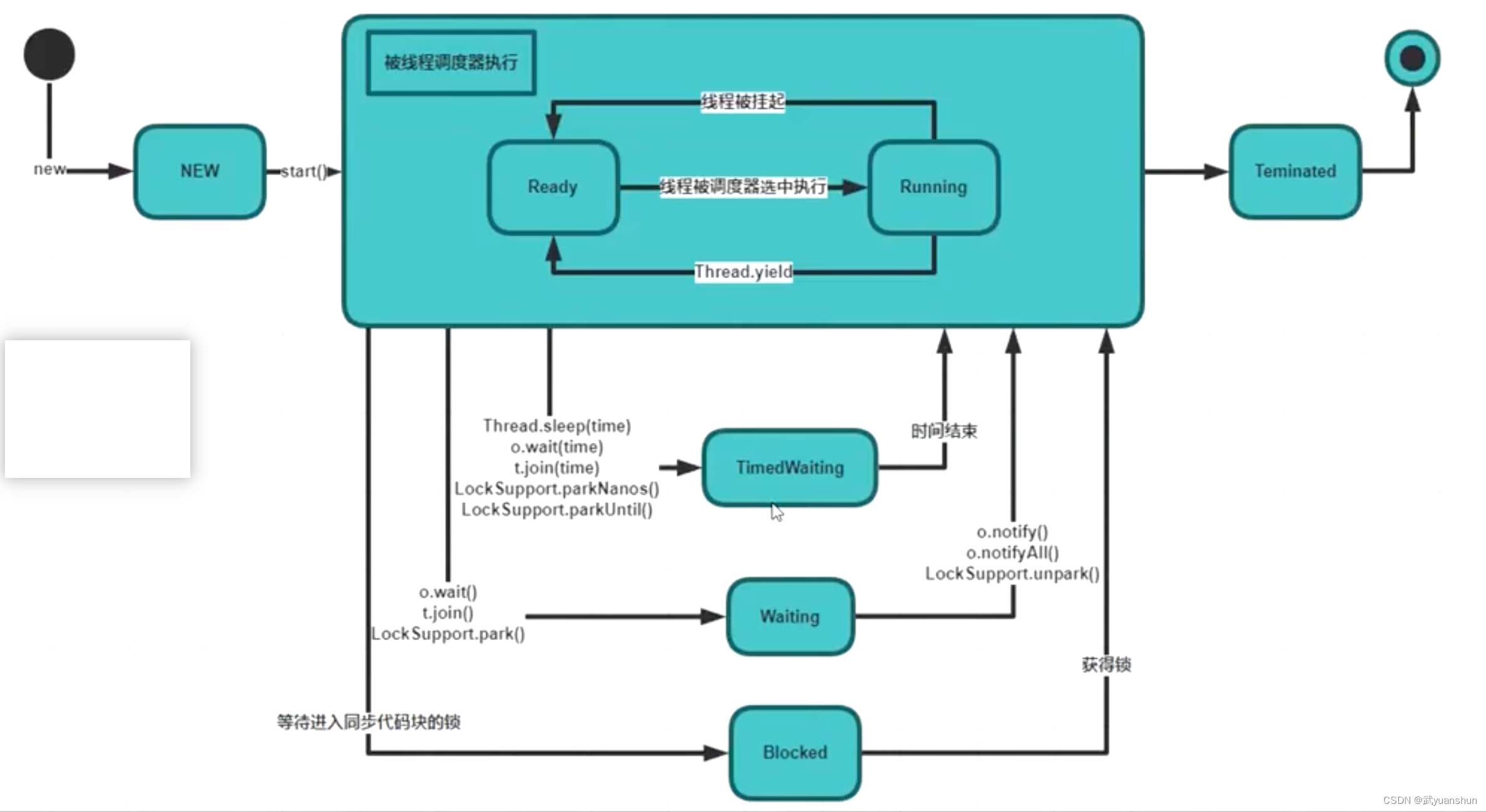
五、synchronized关键字
1.为什么要上锁?
多线程访问操作相同资源时,需要加锁。如i++;由两个线程同时调用i++;正常结果是2,但是结果可能会出现1,两个线程同时读取i=0,加1后把i=1;写回。导致结果出现i=1;
2.锁定的内容是什么?
锁定的内容是对象。底层实现是对象的内存接口mark word中最后两个字节的状态00、01、10、11。
最好不要使用java中的常亮对象String、Long、Integer等作为锁对象。
private int count=10;private Object o=new Object();public void m(){synchronized(o){//任何代码要执行下面代码,必须先拿到o的锁count--;System.out.println(count);}}
3.synchronized加锁的方式
1.可以加在方法中 (代码同上)
2.也可以加在方法上。在在方法方法上锁的对象既是this对象
public synchronized void m2(){//等同于在方法中的代码执行synchronized(this)count--;System.out.println(count); }
4.同步方法和非同步方法是否可以同时调用?
//同步方法指的是加锁的方法,非同步方法则反之。
可以同时调用
public class T {public synchronized void m() {System.out.println("m1 start");try {Thread.sleep(1000);} catch (InterruptedException e) {e.printStackTrace();}System.out.println("m1 end");}public void m2() {System.out.println("m2");}public static void main(String[] args) {T t=new T();new Thread(t::m).start();new Thread(t::m2).start();}
}
运行结果为:
m1 start
m2
m1 end
5.面试题:模拟银行账户,对业务写方法加锁,对业务读方法不加锁,这样行不行?
容易产生脏读问题(dirtyRead),如果业务逻辑中允许脏读可以读取时不加锁,如果业务不允许脏读,则需要加锁。
class Account {String name;double balance;public synchronized void set(String name, double balance) {this.name = name;try {Thread.sleep(2000);} catch (InterruptedException e) {e.printStackTrace();}this.balance = balance;}public /*synchronized*/ double getBalance(String name) {return this.balance;}public static void main(String[] args) {Account a = new Account();new Thread(() -> a.set("zhangsan", 100.0)).start();try {Thread.sleep(1000);} catch (InterruptedException e) {e.printStackTrace();}System.out.println(a.getBalance("zhangsan"));try {Thread.sleep(2000);} catch (InterruptedException e) {e.printStackTrace();}System.out.println(a.getBalance("zhangsan"));}}
上面代码中get方法不加锁运行结果:
0.0
100.0
get方法加synchronized锁运行结果为:
100.0
100.0
6.synchronized是否是可重入锁?
synchronized是可重入锁。
比如父类方法中加了synchronized锁,子类方法也有synchronized锁,子类方法调用super方法及调用父类方法,如果不能重入则会出现死锁。
验证代码:
public class T6 {public synchronized void m() {System.out.println("m1 start");try {Thread.sleep(1000);} catch (InterruptedException e) {e.printStackTrace();}m2();System.out.println("m1 end");}public synchronized void m2() {System.out.println("m2");}public static void main(String[] args) {T6 t=new T6();new Thread(t::m).start();}
}7.程序中出现异常,锁是否会被释放?
在程序中出现异常,默认情况锁会被释放。
所以,在并发处理的过程中,有异常要多加小心,不然可能会发生不一致的情况。
比如,在一个web app处理过程中,多个servlet线程共同访问同一个资源,这时如果异常处理不合适,
在第一个线程中抛出异常,其他线程就会进入同步代码区,有可能会访问到产生时的数据,
因此要非常小心的处理同步业务逻辑中的异常
8.synchronized的底层实现
JDK早期的 重量级 -OS
后来改进为锁升级
锁升级概念: 没错,我就是厕所所长!(一)
没错,我就是厕所所长!(二)
markword 记录这个线程ID(偏向锁)
如果有线程争用:升级为自旋锁;
自旋10次以后,升级为重量级锁 - OS
//锁不能降级
使用场景: 线程比较少且执行时间短用自旋锁;线程数量比较多或执行时间长用系统锁;
六、Volatile关键字
1.保证线程可见性
- MESI(MESI协议是基于Invalidate的高速缓存一致性协议,并且是支持回写高速缓存的最常用协议之一) 缓存一致性协议
可以先看一下下面的代码,m方法while处会死循环,除非修改了running=false;
再看一main方法,它开启了一个新线程执行了方法m,之后睡眠1秒后执行running=false;,执行结果只有‘m start’没有‘m end’。
原因是cpu在执行新线程时 把资源(如running)拷贝了一份到CPU内执行,这样比从内存中取快了100倍左右。但是存在着一些问题,比如其他线程中修改了running,但是另一个线程不知道。
所以当线程2修改了变量r,要同步到内存,并且通知其他线程去内存重新获取变量。
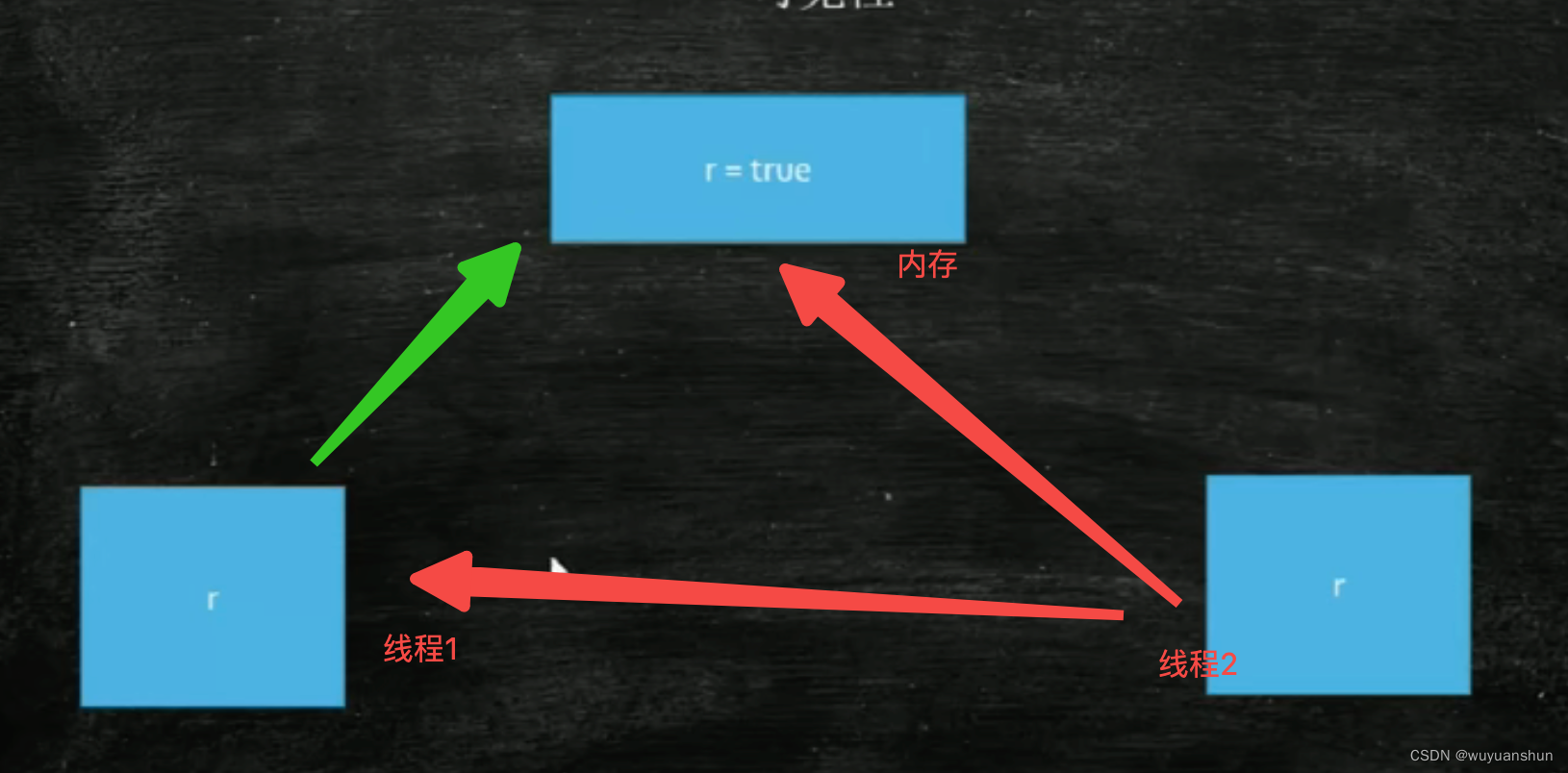
public class HelloVolatile {
// volatile boolean running = true;boolean running = true;void m() {System.out.println("m start");while (running) {
// System.out.println("hello");}System.out.println("m end");}public static void main(String[] args) {try {T01_HelloVolatile t = new T01_HelloVolatile();new Thread(t::m, "t1").start();Thread.sleep(1000);t.running = false;} catch (InterruptedException e) {e.printStackTrace();}}
}2.禁止指令重排序(CPU)
- DCL单例(Double Check Lock)
通过以下代码,可以验证代码会发生重排序。
如果代码不会重排序则线程1中 ‘a = 1; ’一定在‘x = b;’之前,线程2‘ b = 1;’一定在‘x = b;’之前;
则两个线程运行会出现以下几种情况
// a = 1;
// x = b;
// b = 1;
// y = a;
结果x值为0,y值为1
// a = 1;
// b = 1;
// x = b;
// y = a;
结果x值为1,y值为1
// b = 1;
// y = a;
// a = 1;
// x = b;
结果x值为1,y值为0
但是绝对不会出现( x = b;在a = 1;之前 或 y = a;在b = 1;之前),如果出现了则证明代码回重排序(x值为0,y值为0)。当然需要运行一段时间才会出来结果,可能是3-5分钟后才会出现一次。
// x = b;
// b = 1;
// y = a;
// a = 1;
结果x值为0,y值为0
public class Disorder {private static int x = 0, y = 0;private static int a = 0, b = 0;public static void main(String[] args) throws Exception {int i = 0;for (; ; ) {CountDownLatch countDownLatch = new CountDownLatch(2);i++;x = 0;y = 0;a = 0;b = 0;Thread one = new Thread(new Runnable() {@Overridepublic void run() {//由于one先启动,下面这句话让它等一等线程two,低着乐意根据自己电脑的实际性能适当调整等待时间。a = 1;x = b;countDownLatch.countDown();}});Thread other = new Thread(new Runnable() {@Overridepublic void run() {b = 1;y = a;countDownLatch.countDown();}});one.start();other.start();countDownLatch.await();String result = "第" + i + "次(" + x + "," + y + ")";if (x == 0 && y == 0) {System.out.println(result);break;} else {
// System.out.println(result);}}}
}// a = 1;
// x = b;
// b = 1;
// y = a;// a = 1;
// b = 1;
// x = b;
// y = a;// b = 1;
// y = a;
// a = 1;
// x = b;
如果打印出来x=0 ,y=0则可以证明代码会重排序。
在这里额外扩展一下:如何实现单例模式的线程安全。
java单例模式的线程安全
七、CAS(Compare And Swap /Set / Exchange)(自旋锁 乐观锁) (无锁)
先展示用法,再解释原理。
首先需求是用100个线程同时执行 for循环10000次i++;操作。期望结果是1000000
实现思路1:
public class IPlusPlus {private static long n = 0L;public static void main(String[] args) throws InterruptedException {Thread[] threads = new Thread[100];CountDownLatch latch = new CountDownLatch(threads.length);for (int i = 0; i < threads.length; i++) {threads[i] = new Thread(() -> {for (int j = 0; j < 10000; j++) {
// synchronized (IPlusPlus.class) {n++;
// }}latch.countDown();});}for (Thread thread : threads) {thread.start();}latch.await();System.out.println(n);}
}执行结果是远远达不到1000000的,这是因为n++操作没有加锁。加上synchronized锁后结果即为1000000。如果不用synchronized锁是否有其他方案呢?
以下便是使用Atomic 自旋锁:
实现思路2:
public class TAtomicInteger {static AtomicInteger count = new AtomicInteger(0);/* synchronized */ void m() {for (int i = 0; i < 10000; i++) {//CAS Compare And Swap /Set / Exchange (自旋锁,乐观锁) (无锁)count.incrementAndGet();}}
//两种锁的效率//不同场景://临界区执行时间比较长,等的人很多--》重量级//时间短,等的人少--》自旋锁public static void main(String[] args) {TAtomicInteger t = new TAtomicInteger();List<Thread> threadList = new ArrayList<>();for (int i = 0; i < 100; i++) {threadList.add(new Thread(t::m, "thread-" + i));}threadList.forEach(Thread::start);//等待线程执行完threadList.forEach((o) -> {try {o.join();} catch (InterruptedException e) {e.printStackTrace();}});//线程执行完再打印结果System.out.println(count);}
}以上代码没有使用synchronized锁,结果也可以打印出期望值1000000。这是如何实现的呢?
我们来看一下这个incrementAndGet();方法的源码:
1.AtomicInteger类
第一层AtomicInteger类(只截取了关键代码信息)
public class AtomicInteger extends Number implements java.io.Serializable {/ This class intended to be implemented using VarHandles, but there* are unresolved cyclic startup dependencies.* 这个类打算使用VarHandles来实现,但是是未解析的循环启动依赖项。*/private static final jdk.internal.misc.Unsafe U = jdk.internal.misc.Unsafe.getUnsafe();private static final long VALUE = U.objectFieldOffset(AtomicInteger.class, "value");private volatile int value;/* Creates a new AtomicInteger with the given initial value.* 使用给定的初始值创建一个新的AtomicInteger。* @param initialValue the initial value*/public AtomicInteger(int initialValue) {value = initialValue;}/* Creates a new AtomicInteger with initial value {@code 0}.* 使用初始值创建新的AtomicInteger*/public AtomicInteger() {}//…………………………/* Atomically increments the current value,* with memory effects as specified by {@link VarHandle#getAndAdd}.* 原子地增加当前值,具有由{@link VarHandle#getAndAdd}指定的内存效果。* <p>Equivalent to {@code addAndGet(1)}. @return the updated value 更新后的值*/public final int incrementAndGet() {return U.getAndAddInt(this, VALUE, 1) + 1;}//…………………………
}
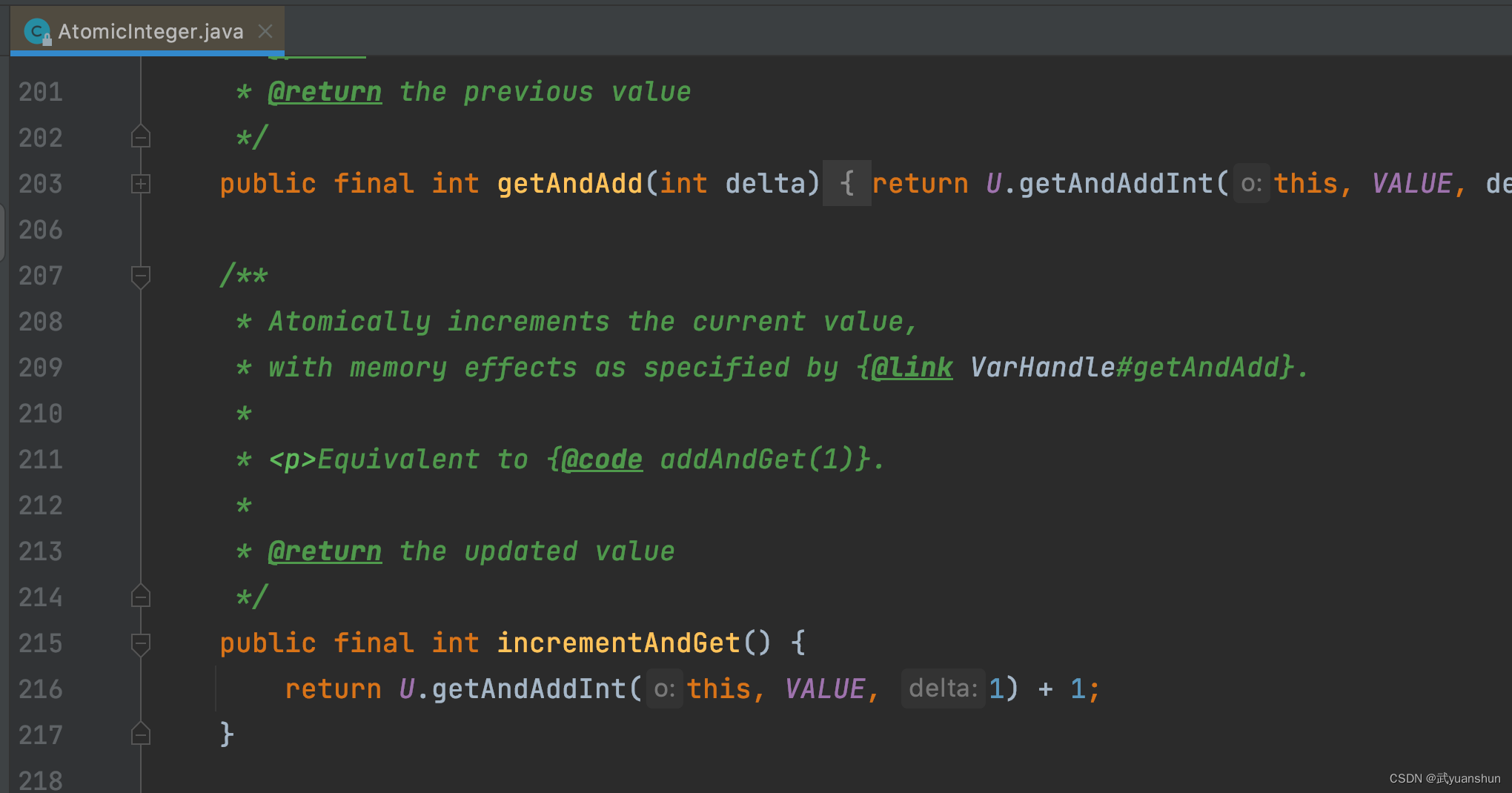
通过追踪源码可以看到incrementAndGet调用了Unsafe类的getAndAddInt();方法,下面我们继续追踪。
2.Unsafe类
通过以下代码可以看出Unsafe类是单例的,且核心方法是用native修饰的(C++实现)
/* A collection of methods for performing low-level, unsafe operations.* Although the class and all methods are public, use of this class is* limited because only trusted code can obtain instances of it.* 用于执行低级别,unsafe操作的方法的集合。* 尽管该类和所有方法都是公共的,但该类的使用受限,因为只有受信任的代码才能获得它的实例。* * @author John R. Rose* @see #getUnsafe*/public final class Unsafe {private static native void registerNatives();static {registerNatives();}private Unsafe() {}private static final Unsafe theUnsafe = new Unsafe();/* Provides the caller with the capability of performing unsafe* operations.* 为调用方提供执行unsafe操作的能力。/public static Unsafe getUnsafe() {return theUnsafe;}
//……………………/ Volatile version of {@link #getInt(Object, long)} */@HotSpotIntrinsicCandidatepublic native int getIntVolatile(Object o, long offset);//……………………// The following contain CAS-based Java implementations used on//以下包含在上使用的基于CAS的Java实现// platforms not supporting native instructions//不支持本机指令的平台/* Atomically adds the given value to the current value of a field* or array element within the given object {@code o}* at the given {@code offset}.* 将给定值原子化地添加到字段的当前值* 或给定对象内的数组元素{@code o}* 在给定的{@code偏移量}处。 @param o object/array to update the field/element in 对象/数组以更新中的字段/元素* @param offset field/element offset 偏移字段/元素偏移* @param delta the value to add 增量要添加的值* @return the previous value 以前的值* @since 1.8*/@HotSpotIntrinsicCandidatepublic final int getAndAddInt(Object o, long offset, int delta) {int v;do {v = getIntVolatile(o, offset);} while (!weakCompareAndSetInt(o, offset, v, v + delta));return v;}@HotSpotIntrinsicCandidatepublic final boolean weakCompareAndSetInt(Object o, long offset,int expected,int x) {return compareAndSetInt(o, offset, expected, x);}/* Atomically updates Java variable to {@code x} if it is currently* holding {@code expected}.* 如果Java变量当前持有{@code expected},则原子化地将其更新为{@code x}。 <p>This operation has memory semantics of a {@code volatile} read* and write. Corresponds to C11 atomic_compare_exchange_strong.* 此操作具有{@code volatile}读写的内存语义。对应于C11 atomic_compare_exchange_strong。 @return {@code true} if successful 如果成功*/@HotSpotIntrinsicCandidatepublic final native boolean compareAndSetInt(Object o, long offset,int expected,int x);//……………………}
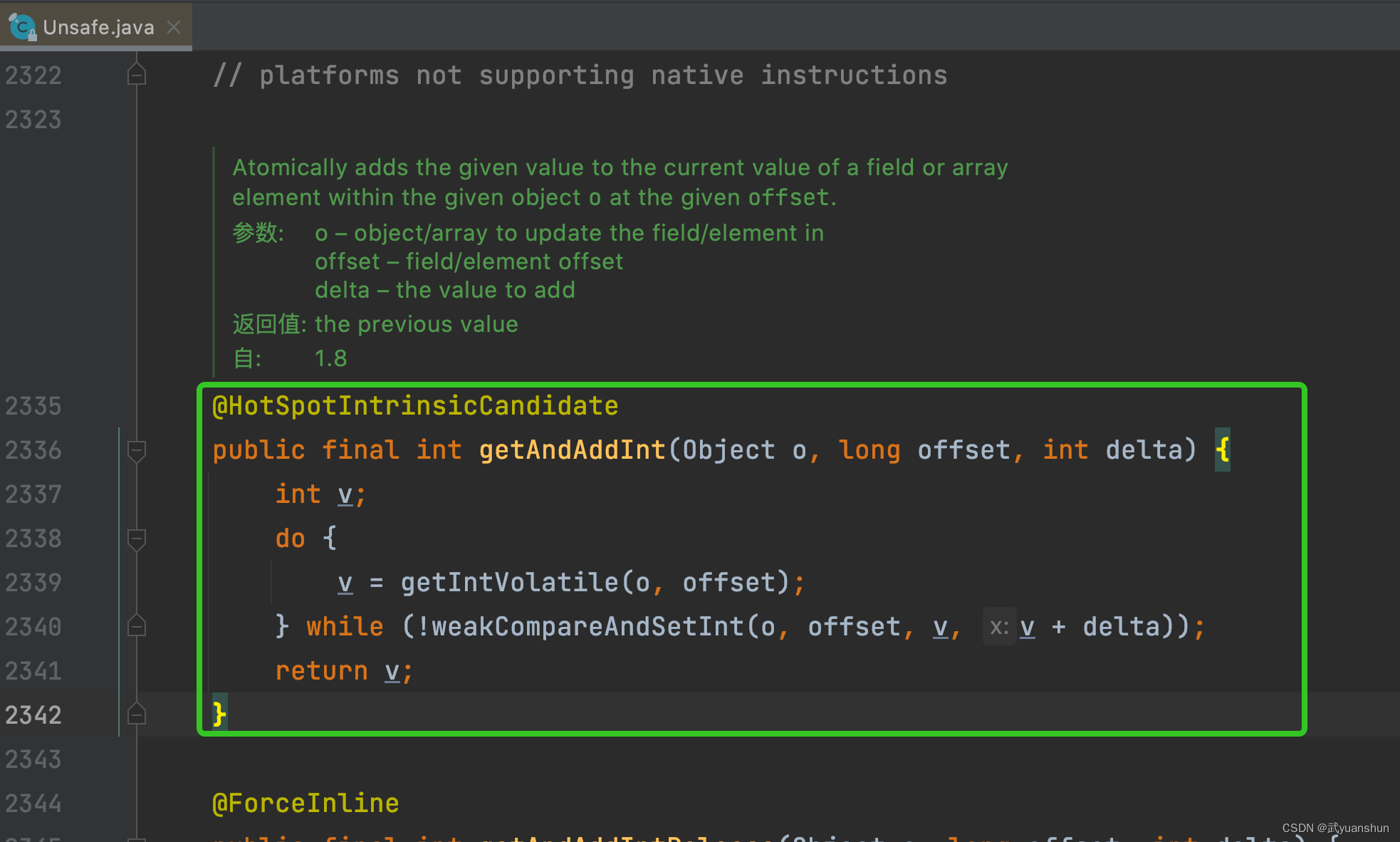
上图可以说是一段比较核心cas(compareAndSet 比较并且设置)逻辑,从代码中我们可以看出使用了do{循环执行的语句} while(是否继续循环)语句,首先执行获取当前值v
我自己用java写的代码逻辑 助于理解,不是真的底层实现!
public final int getAndAddInt(Object o, long offset, int delta) {int v;do {v = getIntVolatile(o, offset);//如果返回false 则再次获取v值。} while (!weakCompareAndSetInt(o, offset, v, v + delta));return v;}
/* 此方法不是源码 */public final boolean compareAndSetInt(Object o, long offset, int v, int x){//当然 以下代码只是逻辑 在C++中一句汇编语言带代替 实现原子性。if (v == value) {//v=1, x=2,value = x;return true;//如value也为1 则设置成功 返回true;}return false;//如value不为1 返回false; }然后进入循环判断 是否比较并设置成功了(compareAndSetInt();)
所以核心方式是compareAndSetInt ,但是这个方法是native修饰的,也就是C++语言实现的这个方法:
1)Unsafe类的C++源码追踪
首先我们定位到Unsafe.cpp类的Unsafe_CompareAndSwapInt方法:
Unsafe.cpp
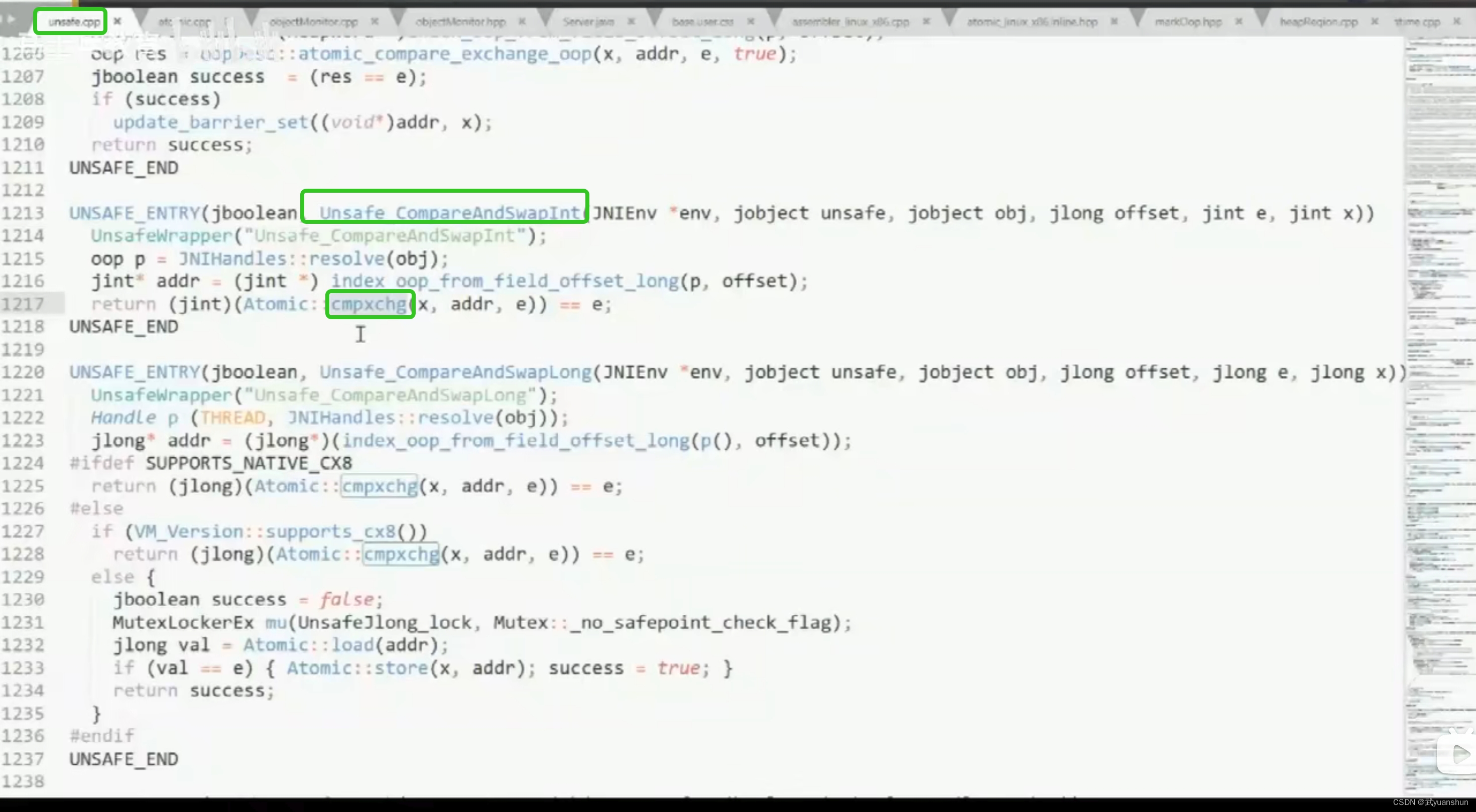
最终定位到atomtic_liunx_x86.inline.hpp文件的cmpxchg方法。
jdk8u:atomtic_liunx_x86.inline.hpp 93行:
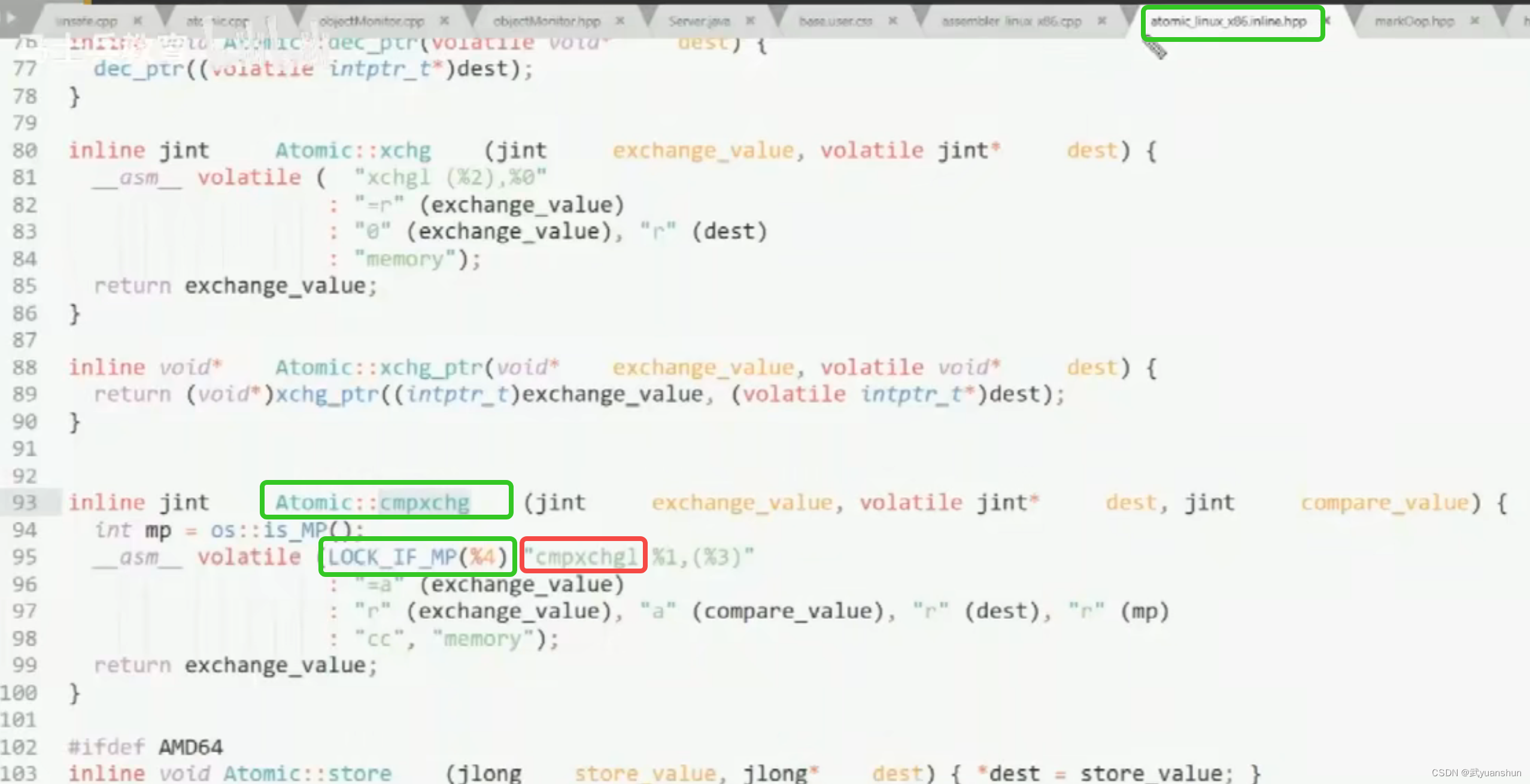
LOCK_IF_MP方法逻辑:

2) C++中cmpxchg方法解释
- asm : 汇编码
- LOCK_IF_MP: Multi-processors(多cpu) 多个cpu情况下 要加lock锁执行令,作用只允许一个cpu操作,可以保证此命令的操作原子性。
- cmpxchgl: compare and exchange(比较并交换)
所以最终执行令是 lock加cmpxchg
lock comxchg 指令


